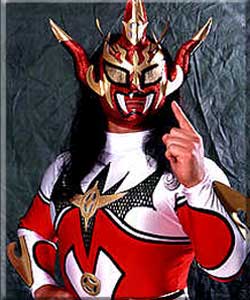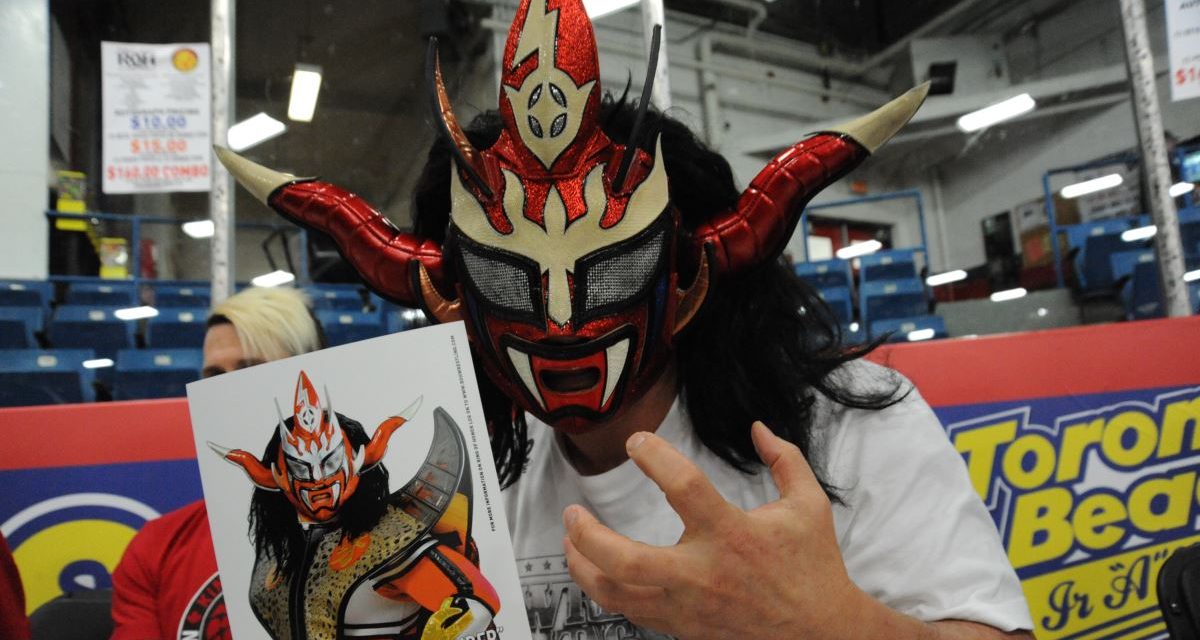It’s hard to say what the final legacy of Jushin “Thunder” Liger will be. What men like Ric Flair are to North American wrestling, Liger is to Japanese wrestling, especially the Junior Heavyweight style that has grown in popularity over the past 15 years. Every high-flying wrestler today from Rey Mysterio to AJ Styles owes their success in part to Liger and today young junior heavyweights dream of stepping into the ring with Liger.
Born November 10, 1964, in Hiroshima, Keiichi Yamada was a lifelong wrestling fan, and an amateur standout in high school. When he applied to the New Japan dojo he was told he was too small so he set off to Mexico to learn there. A NJPW talent scout saw him while on a tour and offered him the opportunity to join the Dojo. Yamada was part of the same training camp that produced Keiji Muto, Masahiro Chono and Shinya Hashimoto before making his pro debut on March 3, 1984 against Shunji Kosugi. He worked the undercard for two years before winning New Japan’s Young Lions Cup tournament on March 26, 1986. From there Yamada was sent to England before his career took a Canadian twist. He was sent to Stu Hart’s Stampede Wrestling in May of 1987.

Jushin “Thunder” Liger
Ross Hart remembered Yamada’s Calgary days. “The office was grooming him as a future junior champion there, so they wanted him to get some exposure in Stampede Wrestling. Many Japanese wrestlers had benefited so well from their training and wrestling here such as Hiro Hase, who wrestled in the Viet Kong Express. He was here for four months and we were sad to see him go,” Hart said. “Some of his best matches here were against Cuban Assassin, and Jerry Morrow as well as teaming with Mr. Hito against the Viet Kong Express. It was a good team with Hito being the ring general veteran and Yamada being the younger high-flying star. It was a nice contrast.”
Today’s fans may not realize it, but Liger worked very hard to have a good physique despite his small stature. It’s now hidden behind a bodysuit but Yamada wore trunks in his early years.
“He had a tremendous upper body and huge neck, yet he was so acrobatic and fast moving. He did a lot of amateur wrestling and submission wrestling and it all came together into a excellent package. He was a very humble charismatic star at that time,” said Hart.
His humbleness appealed to the Stampede locker room. They easily took to the young high flyer.
“He was a pleasure to be around in the dressing room, very quiet and kept to himself. He was always smiling and the boys all took to him. We wished he could have stayed longer. They brought him back once specifically to wrestle Owen, as he was about to go on his first tour of New Japan. It was ironic because they had teamed up on some shows here,” said Hart. “His trip here was very successful because he absorbed the North American style and perform on his own out of the shadow of other Japanese wrestlers that he likely idolized such as The Cobra, Tiger Mask, Hiro Saito or Kobashi. He had more of his own identity.”
Yamada’s career would continue to be intertwined with the Alberta wrestling scene to this day. His battles in which he traded the IWGP Jr. Heavyweight Title with Owen Hart and Chris Benoit in Japan are legendary, while his 1992 matches in WCW against Brian Pillman were far ahead of anything seen in North America at that time. Lance Storm and Chris Jericho have both spoken fondly of Liger, and today the tradition continues; “Stampede Kid” TJ Wilson has faced Liger in tag matches numerous times in the past two years.
“It was a mutual respect they all had for each other. Jericho and Storm came along after Liger left but they had common history of Dungeon experience,” Wilson said. “It made for some interesting storylines over there as well. Since the Liger role was so successful I think they reinvented Benoit as the Pegasus Kid. Owen had fantastic matches with both of them as well.”
Even in 1987, Hart suspected Yamada had big things in store for him. “At that time I thought he had a great future. He reminded me a lot of Tiger Mask, who wasn’t much taller than him, and El Gran Hamada. They were looking for a successor to The Cobra and Tiger Mask and when they sent him to Calgary it was a good indication that it would increase his stature considerably and give him more respect and credibility. His predecessors had been used very well when they went back to Japan and I expected no differently from them.”
Within a year and a half a Japanese cartoon aired about Jushin Liger that became very popular. Yamada was repackaged in the outfit he wears to this day, debuting at the very first wrestling event at the Tokyo Dome on April 24, 1989, defeating Kuniaki Kobayashi, one of Tiger Mask’s biggest rivals from his glory days in the early ’80s.
As great of a wrestler as Liger is, he also has an excellent mind for the business and became the booker of the Junior Heavyweight Division in New Japan, creating the J-Cup and Best of the Super Junior tournaments.
“I think what gets overlooked about Liger was his strength as a booker of New Japan’s junior heavyweight division,” said former SLAM! Wrestling contributor John Molinaro, who lists Liger as number 36 in his book Top 100 Pro Wrestlers of All Time. “Liger’s precision booking was masterful, and it was intricate and compelling to the point that it should be put in a wrestling textbook and studied by aspiring bookers.”
Dave Meltzer, editor of the Wrestling Observer Newsletter agrees. “He was by far the biggest star of his division, and was so big, that he could create stars with just one win over him. It wasn’t going to work forever, but he had a great run with it.”
His selflessness helped many aspiring stars go onto greatness. The first Super J Cup was held in April of 1994 and Liger lost in the semi-finals to The Great Sasuke, who in turn lost the final bout to “Wild Pegasus” Chris Benoit. Two years later Liger did the unthinkable by putting together the J-Crown tournament in August 1996. The week-long event featured eight different junior heavyweight champions from five different promotions in Japan and Mexico during New Japan’s annual G1 Climax tournament in attempt to unify the belts into one title. Liger lost in the first round to Ultimo Dragon, who lost the final match to The Great Sasuke. The belts would later appear on WCW television, Ultimo Dragon briefly held the J-Crown in addition to their Cruiserweight title. The same day as the finals, Liger announced he had a brain tumor and his career might be over. Fortunately it was benign and after an operation to remove it Liger returned, altering his style to include more mat wrestling and storytelling.
“When he picked up so many injuries from the high flying style of his, he did a great job of changing styles and being one of the best at a new style. He understood how to get over much safer moves like the shote as opposed to crazy topes. He’s probably as big a star as could have been possible for a 5’4″ 205 pound guy who came along during the era he came along in,” said Meltzer.
Liger is the creator of the Shooting Star Press and Puroresu fans speak of moves like the Ligerbomb (sit out powerbomb), Fishermanbuster and Koppou Kick with reverence. It speaks to Liger’s influence that the Shooting Star has been used by a vast array for wrestlers such as Marc Mero, Billy Kidman, Paul London, Brock Lesnar, and many others.
Liger has had limited exposure in the U.S., but his matches have all been excellent. At Clash of the Champions XIX in June of 1992 he teamed with Brian Pillman to defeat Chris Benoit and Biff Wellington, all Dungeon graduates. Three years later he defeated Benoit in the opening match of Starrcade 1995’s “New Japan vs. WCW World Cup of Wrestling.” He returned a year later to face Rey Mysterio at the event in a cruiserweight dream match. His last WCW appearances would be less memorable as he feuded with Juventud Guerrera, resulting in the famous and hated tequila bottle to the head loss.
It is in Japan however that Liger has truly shined, his matches are hot items among tape sellers and fans continue to debate his greatest matches. He has had epic battles with Ultimo Dragon, Chris Benoit, Eddie Guerrero (wrestling under a mask as Black Tiger), El Samurai, Naoki Sano, Koji Kanemoto, Ultimo Dragon, Great Sasuke and Super Delfin.
Meltzer can’t pick a standout match. “It’s hard to pick his best matches, because there are so many. He was the junior heavyweight star in pro wrestling in the early ’90s, and except for Satoru Sayama, I think the biggest ever. There are so many great matches from Chris Benoit to Great Sasuke to Koji Kanemoto, Shinjiro Otani, and so many others.”
After 20 years in the business, Liger still is not done. He has crossed promotional boundaries working for Pro Wrestling Noah, where he has held their jr. title, and Michinoku Pro. Recently he has turned heel in Japan and dons a black outfit to represent this fact. Despite injuries and age, Liger is proving his longevity and shows no sign of stopping anytime soon. He has been a true pioneer and innovator for the scene and a legend no one may match. That legend will live on long after he dons the pointed red mask for the final time.
RELATED LINK

